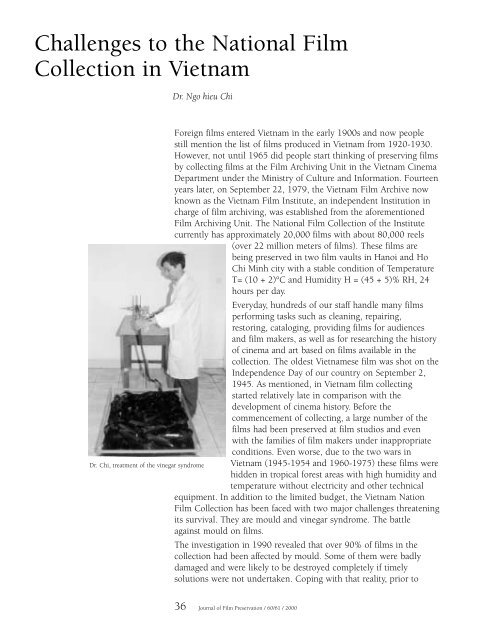Journal of Film Preservation N° 60/61 - FIAF
Journal of Film Preservation N° 60/61 - FIAF
Journal of Film Preservation N° 60/61 - FIAF
You also want an ePaper? Increase the reach of your titles
YUMPU automatically turns print PDFs into web optimized ePapers that Google loves.
Challenges to the National <strong>Film</strong><br />
Collection in Vietnam<br />
Dr. Ngo hieu Chi<br />
Dr. Chi, treatment <strong>of</strong> the vinegar syndrome<br />
Foreign films entered Vietnam in the early 1900s and now people<br />
still mention the list <strong>of</strong> films produced in Vietnam from 1920-1930.<br />
However, not until 1965 did people start thinking <strong>of</strong> preserving films<br />
by collecting films at the <strong>Film</strong> Archiving Unit in the Vietnam Cinema<br />
Department under the Ministry <strong>of</strong> Culture and Information. Fourteen<br />
years later, on September 22, 1979, the Vietnam <strong>Film</strong> Archive now<br />
known as the Vietnam <strong>Film</strong> Institute, an independent Institution in<br />
charge <strong>of</strong> film archiving, was established from the aforementioned<br />
<strong>Film</strong> Archiving Unit. The National <strong>Film</strong> Collection <strong>of</strong> the Institute<br />
currently has approximately 20,000 films with about 80,000 reels<br />
(over 22 million meters <strong>of</strong> films). These films are<br />
being preserved in two film vaults in Hanoi and Ho<br />
Chi Minh city with a stable condition <strong>of</strong> Temperature<br />
T= (10 + 2)°C and Humidity H = (45 + 5)% RH, 24<br />
hours per day.<br />
Everyday, hundreds <strong>of</strong> our staff handle many films<br />
performing tasks such as cleaning, repairing,<br />
restoring, cataloging, providing films for audiences<br />
and film makers, as well as for researching the history<br />
<strong>of</strong> cinema and art based on films available in the<br />
collection. The oldest Vietnamese film was shot on the<br />
Independence Day <strong>of</strong> our country on September 2,<br />
1945. As mentioned, in Vietnam film collecting<br />
started relatively late in comparison with the<br />
development <strong>of</strong> cinema history. Before the<br />
commencement <strong>of</strong> collecting, a large number <strong>of</strong> the<br />
films had been preserved at film studios and even<br />
with the families <strong>of</strong> film makers under inappropriate<br />
conditions. Even worse, due to the two wars in<br />
Vietnam (1945-1954 and 19<strong>60</strong>-1975) these films were<br />
hidden in tropical forest areas with high humidity and<br />
temperature without electricity and other technical<br />
equipment. In addition to the limited budget, the Vietnam Nation<br />
<strong>Film</strong> Collection has been faced with two major challenges threatening<br />
its survival. They are mould and vinegar syndrome. The battle<br />
against mould on films.<br />
The investigation in 1990 revealed that over 90% <strong>of</strong> films in the<br />
collection had been affected by mould. Some <strong>of</strong> them were badly<br />
damaged and were likely to be destroyed completely if timely<br />
solutions were not undertaken. Coping with that reality, prior to<br />
36 <strong>Journal</strong> <strong>of</strong> <strong>Film</strong> <strong>Preservation</strong> / <strong>60</strong>/<strong>61</strong> / 2000
















